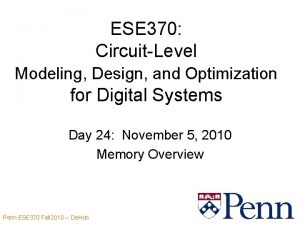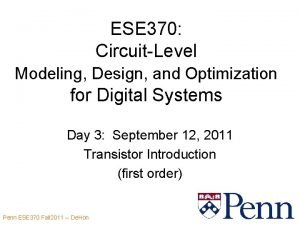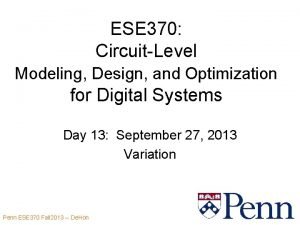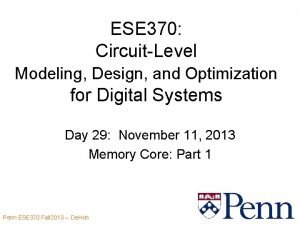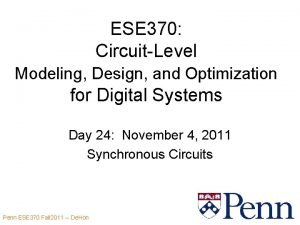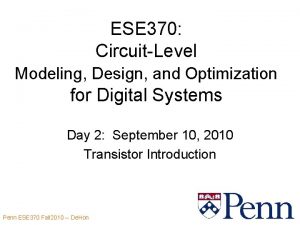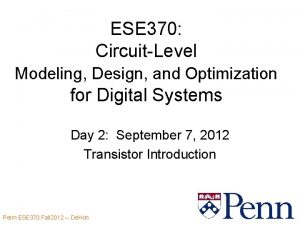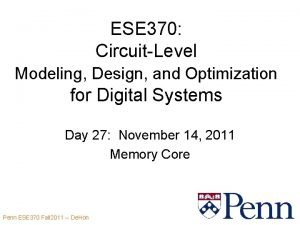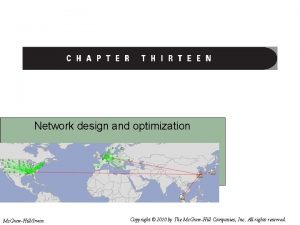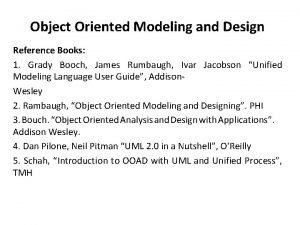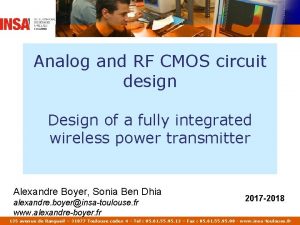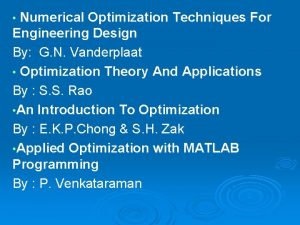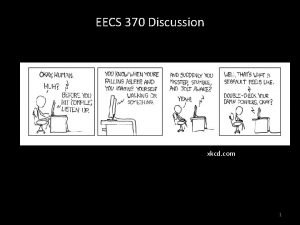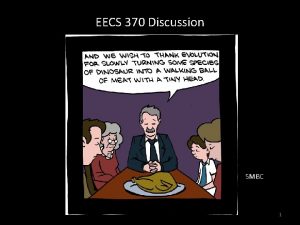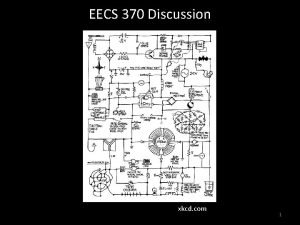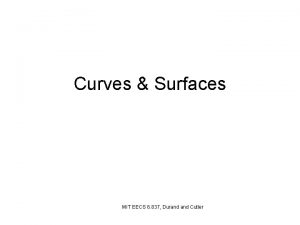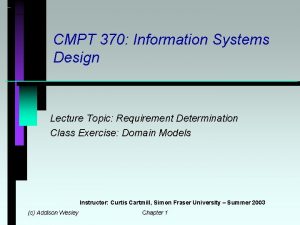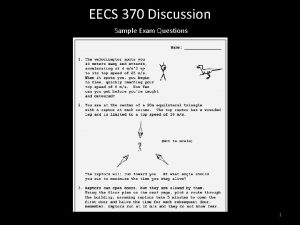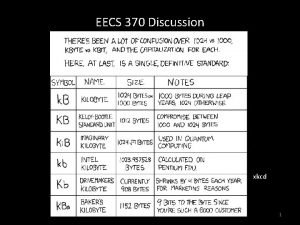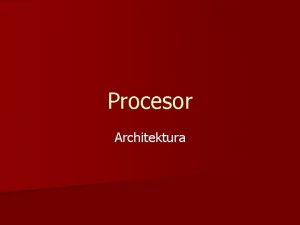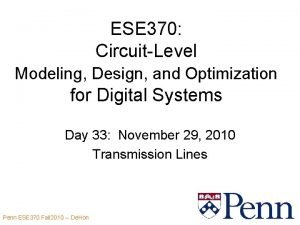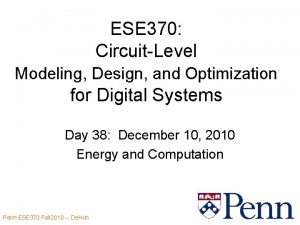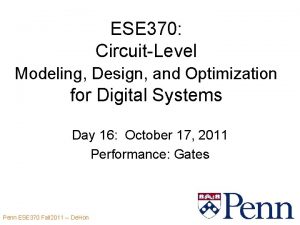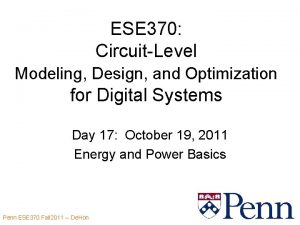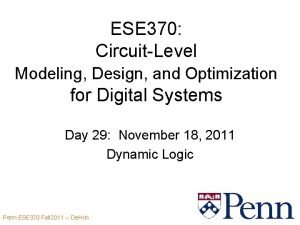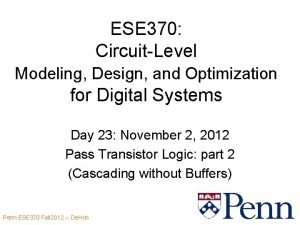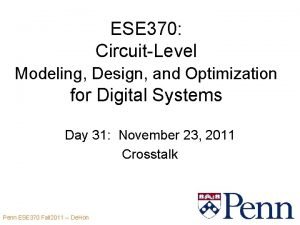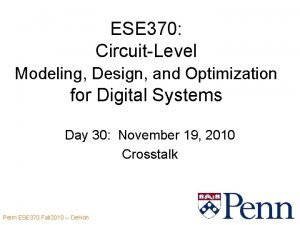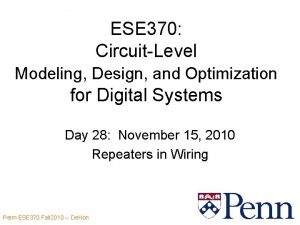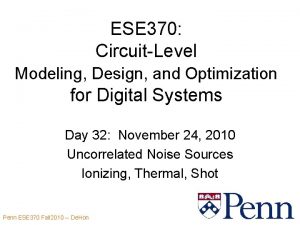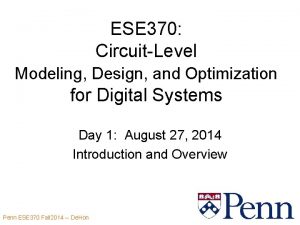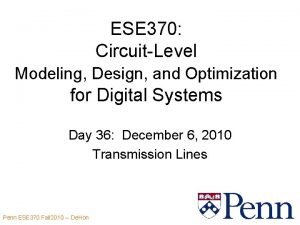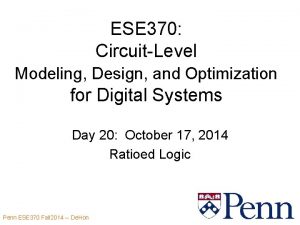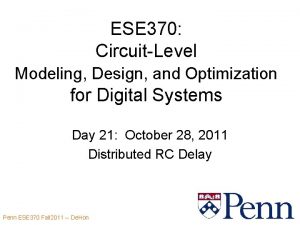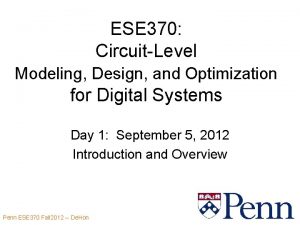ESE 370 CircuitLevel Modeling Design and Optimization for



























































- Slides: 59

ESE 370: Circuit-Level Modeling, Design, and Optimization for Digital Systems Day 2: September 10, 2010 Transistor Introduction Penn ESE 370 Fall 2010 -- De. Hon 1

Today • MOSFET • Capacitive and resistive loads • Simplified models – Zero-th order model • Good enough for ? ? ? – First order model • There always Rs and Cs Penn ESE 370 Fall 2010 -- De. Hon 2

MOSFET • Metal Oxide Semiconductor Field Effect Transistor – New device – Primary active component for the term – Three terminal device • Voltage at gate controls conduction between two other terminals (source, drain) Penn ESE 370 Fall 2010 -- De. Hon 3

MOSFET I vs. Vgs, Vds Penn ESE 370 Fall 2010 -- De. Hon 4

MOSFET I vs. Vgs, Vds • Will dig into understanding during term • Today simple ways to reason about gross behavior – Static/DC Penn ESE 370 Fall 2010 -- De. Hon 5

Preclass • What voltage do the cases converge to? Penn ESE 370 Fall 2010 -- De. Hon 6

Penn ESE 370 Fall 2010 -- De. Hon 7

Penn ESE 370 Fall 2010 -- De. Hon 8

Penn ESE 370 Fall 2010 -- De. Hon 9

Penn ESE 370 Fall 2010 -- De. Hon 10

Penn ESE 370 Fall 2010 -- De. Hon 11

Penn ESE 370 Fall 2010 -- De. Hon 12

Penn ESE 370 Fall 2010 -- De. Hon 13

Conclude? • DC/Steady-State – Ignore the capacitors Penn ESE 370 Fall 2010 -- De. Hon 14

Quasistatic • Static – inputs (and circuit) unchanging, how does it settle? • Dynamic – what happens when things change • Quasi-Static – inputs transition, circuit responds, and settles – Dynamic transition to roughly static states Penn ESE 370 Fall 2010 -- De. Hon 15

Quasistatic Relevance? • How relevant to a combinational digital circuit? • How relevant to a clocked digital circuit? Penn ESE 370 Fall 2010 -- De. Hon 16

Zero-th Order MOSFET • Ideal Switch Vgs > Vth conducts Vgs < Vth does not conduct Vth – threshold voltage Penn ESE 370 Fall 2010 -- De. Hon 17

Zero-th Order MOSFET Penn ESE 370 Fall 2010 -- De. Hon 18

N-Type, P-Type • N – negative carriers • P – positive carriers – electrons • Switch turned on positive Vgs – holes • Switch turned on negative Vgs Vth<0 Vgs<Vth to to conduct Penn ESE 370 Fall 2010 -- De. Hon 19

Why useful? Penn ESE 370 Fall 2010 -- De. Hon 20

What happens when Vin=Vdd>Vth Penn ESE 370 Fall 2010 -- De. Hon 21

What happens when Vin=Vdd>Vth Penn ESE 370 Fall 2010 -- De. Hon Vgs=Vdd > Vth 22

What happens when Vin=Vdd>Vth Penn ESE 370 Fall 2010 -- De. Hon Vgs=Vdd > Vth 23

What happens when Vin=Vdd>Vth Vgs=0 > Vth Penn ESE 370 Fall 2010 -- De. Hon Vgs=Vdd > Vth 24

What happens when Vin=Vdd>Vth Vgs=0 > Vth Penn ESE 370 Fall 2010 -- De. Hon Vgs=Vdd > Vth 25

What happens when Vin=Vdd>Vth Vgs=0 > Vth V 2=Gnd Penn ESE 370 Fall 2010 -- De. Hon Vgs=Vdd > Vth 26

What happens when Vin=Vdd>Vth Vgs=0 > Vth V 2=Gnd Penn ESE 370 Fall 2010 -- De. Hon Vgs=Vdd > Vth Vgs=0 < Vth 27

What happens when Vin=Vdd>Vth Vgs=0 > Vth Vgs=-Vdd < Vth V 2=Gnd Penn ESE 370 Fall 2010 -- De. Hon Vgs=Vdd > Vth Vgs=0 < Vth 28

What happens when Vin=Vdd>Vth Vgs=0 > Vth Vgs=-Vdd < Vth V 2=Gnd Penn ESE 370 Fall 2010 -- De. Hon Vgs=Vdd > Vth Vgs=0 < Vth Vout=Vdd 29

What happens when Vin=0<Vth Penn ESE 370 Fall 2010 -- De. Hon 30

What happens when Vin=0<Vth V 2=Vdd Penn ESE 370 Fall 2010 -- De. Hon Vout=0 31

What function? Buffer • Vin=Vdd Vout=Vdd • Vin=0 Vout=0 Penn ESE 370 Fall 2010 -- De. Hon 32

Why Useful? • Allows us to reason (mostly) at logic level about steady-state functionality of typical gate circuits Penn ESE 370 Fall 2010 -- De. Hon 33

Why adequate? • Static analysis – can ignore capacitors • Capacitive loads – resistances don’t matter • Feed forward for gates – – don’t generally have loops – can work forward from known values • Logic drive rail-to-rail – Don’t have to reason about intermediate voltage levels Penn ESE 370 Fall 2010 -- De. Hon 34

What not tell us? • Delay • Dynamics • Behavior if not – Capacitively loaded – Loops Penn ESE 370 Fall 2010 -- De. Hon 35

First Order Model • Switch – Loads input capacitively – Has finite drive strength Penn ESE 370 Fall 2010 -- De. Hon 36

First Order Model Penn ESE 370 Fall 2010 -- De. Hon 37

First Order Model Penn ESE 370 Fall 2010 -- De. Hon 38

Refine to First Order Penn ESE 370 Fall 2010 -- De. Hon 39

Zero-th Order Tells us how switches set (Vin=0) V 2=Vdd Penn ESE 370 Fall 2010 -- De. Hon Vout=0 40

Zero-th Order Tells us how switches set (Vin=0) V 2=Vdd Vout=0 Penn ESE 370 Fall 2010 -- De. Hon 41

Zero-th Order Tells us how switches set (Vin=0) • Leaves an RC Circuit we can analyze Penn ESE 370 Fall 2010 -- De. Hon 42

Zero-th Order Tells us how switches set (Vin=0) • Look at middle stage Penn ESE 370 Fall 2010 -- De. Hon 43

What more this tell us? • Delay • Quastistatic behavior • Voltage settling with resistive loads – At least some basis for reasoning Penn ESE 370 Fall 2010 -- De. Hon 44

What is this leaving out? Penn ESE 370 Fall 2010 -- De. Hon 45

What is this leaving out? Penn ESE 370 Fall 2010 -- De. Hon 46

What leaving out? • What happens at intermediate voltages – Not rail-to-rail • Details of dynamics, including… – Input not transition as step – Intermediate drive strengths change with Vgs – As output charges Vds changes, changing drive strenght • Isn’t really 0 current below threshold Penn ESE 370 Fall 2010 -- De. Hon 47

Engineering Control • Vth – process engineer • Drive strength – circuit engineer control with sizing • Supply voltages – range set by process, detail use by circuit design Penn ESE 370 Fall 2010 -- De. Hon 48

Engineering Control: Threshold Penn ESE 370 Fall 2010 -- De. Hon 49

Engineering Control: Drive Strength Penn ESE 370 Fall 2010 -- De. Hon 50

Wire Capacitance Penn ESE 370 Fall 2010 -- De. Hon 51

Wire Capacitance Penn ESE 370 Fall 2010 -- De. Hon 52

Wire Resistance Penn ESE 370 Fall 2010 -- De. Hon 53

Wire Resistance Penn ESE 370 Fall 2010 -- De. Hon 54

Wire Resistance • Sanity check – Wire twice as long = resistors in series – Wire twice as wide = resistors in parallel Penn ESE 370 Fall 2010 -- De. Hon 55

There always Rs and Cs • Modeling vs. discrete components • Dominant effects – Rbig + Rsmall ≈ Rbig – Cbig || Csmall ≈ Csmall Penn ESE 370 Fall 2010 -- De. Hon 56

Admin • TA: Andrew Townley – Email: atownley – Office Hours: seas • Lecture Monday: building gates – Reading • Lab on Wednesday Penn ESE 370 Fall 2010 -- De. Hon 57

MOSFET Penn ESE 370 Fall 2010 -- De. Hon 58

Big Ideas • MOSFET Transistor as switch • Purpose-driven simplified modeling – Aid reasoning – Sanity check – Simplify design • New perspective on Rs and Cs Penn ESE 370 Fall 2010 -- De. Hon 59
 Ese 370
Ese 370 Ese 370
Ese 370 Ese 370
Ese 370 Ese 370
Ese 370 Ese 370
Ese 370 Ese 370
Ese 370 Vds vgs
Vds vgs Ese 370
Ese 370 Helen c. erickson
Helen c. erickson Relational vs dimensional data modeling
Relational vs dimensional data modeling Network design and optimization
Network design and optimization Process modeling in system analysis and design
Process modeling in system analysis and design System requirements checklist output example
System requirements checklist output example Object-oriented modeling and designs books
Object-oriented modeling and designs books Device modeling for analog and rf cmos circuit design
Device modeling for analog and rf cmos circuit design Numerical optimization techniques for engineering design
Numerical optimization techniques for engineering design Automatic library search is a standard system library.
Automatic library search is a standard system library. Eecs 370 umich
Eecs 370 umich Ibm 360 machine structure
Ibm 360 machine structure Eecs 370 project 1
Eecs 370 project 1 Xkcd scantron
Xkcd scantron Eecs 370 project 4
Eecs 370 project 4 Acq 370
Acq 370 Xkcd circuit
Xkcd circuit Eecs 370 curve
Eecs 370 curve Cmpt 370
Cmpt 370 Csc 370
Csc 370 Csc 370
Csc 370 Eecs 370 project 2
Eecs 370 project 2 714 en yakın yüzlüğe yuvarlama
714 en yakın yüzlüğe yuvarlama Eecs 582
Eecs 582 866-370-3040
866-370-3040 Democritus atomic model diagram
Democritus atomic model diagram Eecs 370
Eecs 370 Isy 370
Isy 370 Architektura cpu
Architektura cpu D2x222
D2x222 Csc 370
Csc 370 Acq 370
Acq 370 Kontinuitetshantering i praktiken
Kontinuitetshantering i praktiken Typiska drag för en novell
Typiska drag för en novell Tack för att ni lyssnade bild
Tack för att ni lyssnade bild Returpilarna
Returpilarna Shingelfrisyren
Shingelfrisyren En lathund för arbete med kontinuitetshantering
En lathund för arbete med kontinuitetshantering Kassaregister ideell förening
Kassaregister ideell förening Tidbok yrkesförare
Tidbok yrkesförare Sura för anatom
Sura för anatom Förklara densitet för barn
Förklara densitet för barn Datorkunskap för nybörjare
Datorkunskap för nybörjare Boverket ka
Boverket ka Debatt mall
Debatt mall Delegerande ledarskap
Delegerande ledarskap Nyckelkompetenser för livslångt lärande
Nyckelkompetenser för livslångt lärande Påbyggnader för flakfordon
Påbyggnader för flakfordon Tryck formel
Tryck formel Publik sektor
Publik sektor Kyssande vind
Kyssande vind Presentera för publik crossboss
Presentera för publik crossboss Vad är ett minoritetsspråk
Vad är ett minoritetsspråk
